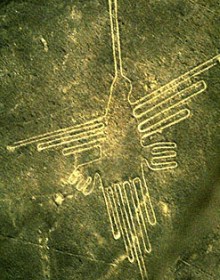resources
Museum Collections - Ancient Peru - Nasca

Located in the Ica and Nasca Valleys of the south coast of Peru, the ancient Nasca culture dominated a large part of southern Peru between 100 B.C. and A.D. 700. The Nasca people lived in a dry desert environment, intersected with rivers carrying rain from the Andes. In areas with sufficient water, they practiced agriculture and exploited marine resources. Because they depended on water and other natural resources to live, many Nasca activities were devoted to the spiritual powers that controlled the forces of nature. The Nasca culture developed out of the earlier Paracas culture, and its beginning is marked by the introduction of slip-painted pottery. Textiles with elaborate decoration and images, including depictions of the ritual use of trophy heads, are found in both late Paracas and early Nasca cultures.
The Nasca are also known for their geoglyphs or "Nasca Lines", geometric forms and giant drawings of birds, animals and other natural forms etched in the desert of southern Peru. The designs of these forms were similar to those found on Nasca textiles and pottery.
Photograph © Philip Baird www.anthroarcheart.org




